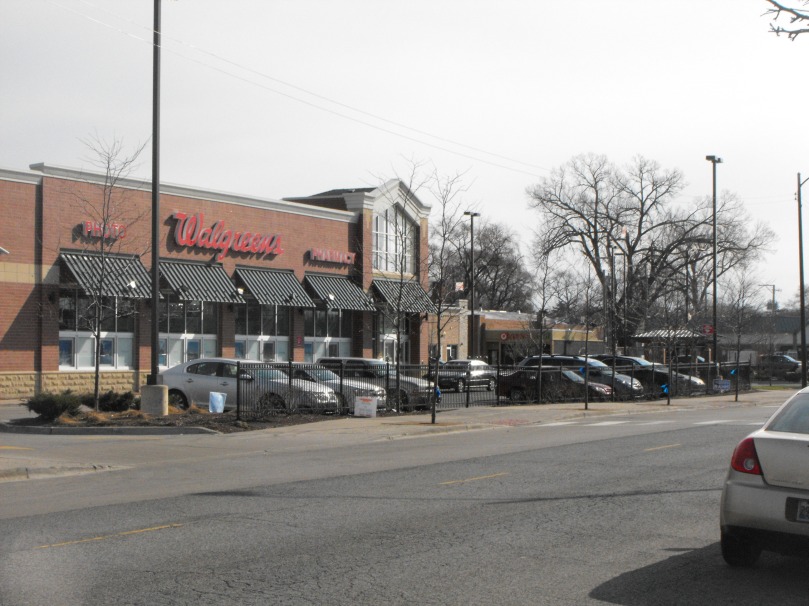
Mount Greenwood’s main shopping district, centered around 111th Street, might be one of the best designed and most pedestrian-friendly in the area. But it’s also a place where properties and businesses in the more walkable sections subsidize encroaching sprawl through taxes.
On the northwest corner of 111th and Kedzie Avenue sits a newer Walgreens, part of a long-term plan for redevelopment of the area. Like other examples of the ubiquitous drug store chain, the Mount Greenwood store sits back from the street, surrounded by a sea of parking that never seems to be as full as envisioned. In a highly walkable, mixed-use area, where the typical building is built to the lot line, includes a storefront that opens to the sidewalk and has minimal — if any — on-site parking, the presence of the sprawling Walgreens and adjoining parking lot is almost confounding.
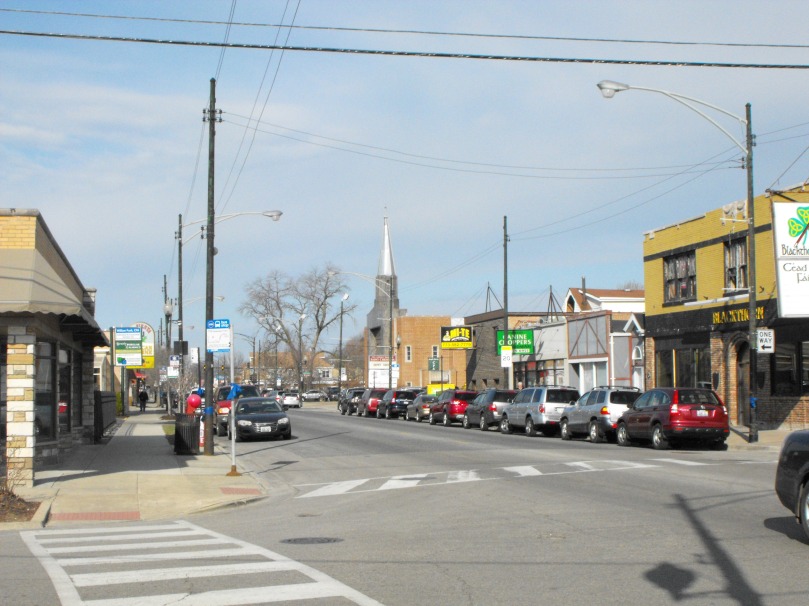
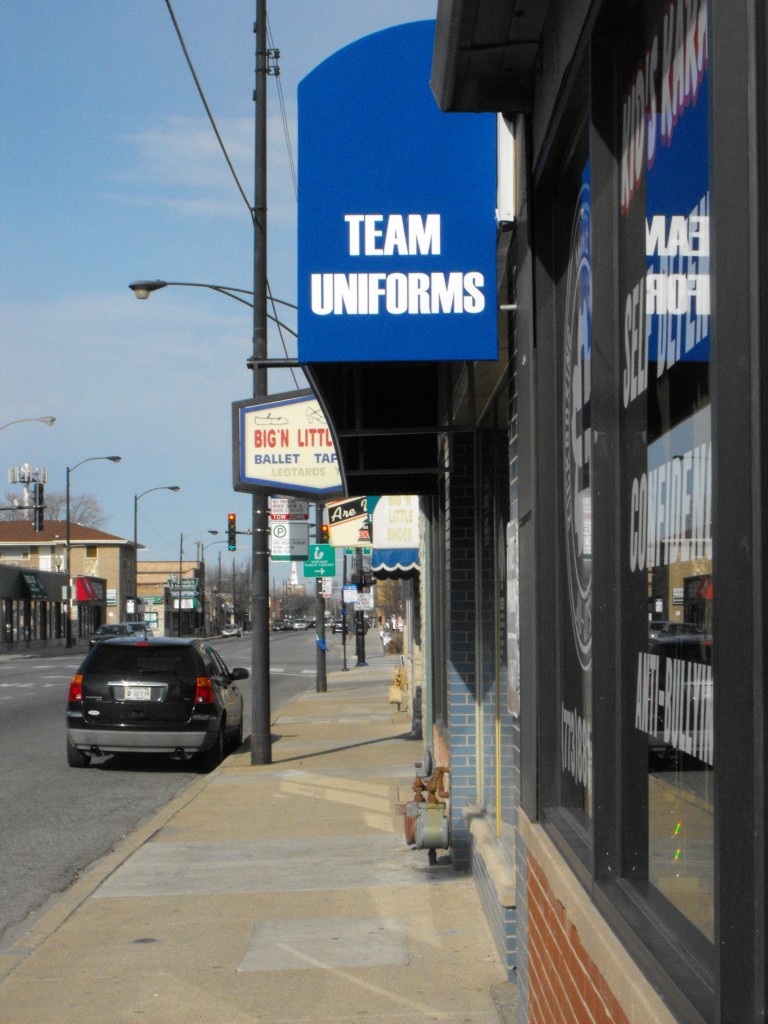
The only indication that the Walgreens development was intended for pedestrian use is a small seating area and brick archway on the corner, doing a less-than-admiral job of screening the parking lot. I’ll get back to this in a minute.
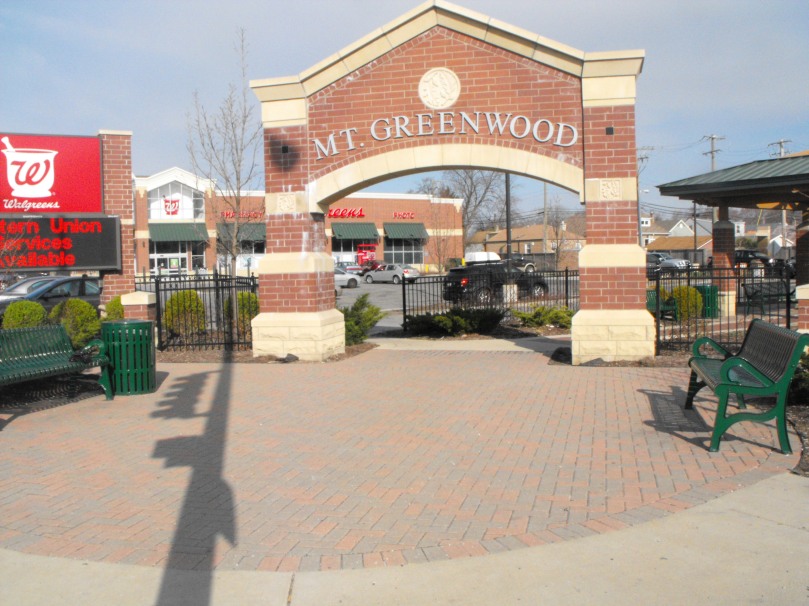
Auto-Orientation Is in the Plan
The development is almost exactly what the neighborhood’s revitalization plan calls for (additional auto-oriented developments on adjacent sites are still unrealized). In 1997, the former Mount Greenwood Local Redevelopment Corporation — now the Mount Greenwood Community and Business Association — worked with the firm Camiros to devise a new vision for the neighborhood. (Camiros is also behind plans that called for such sprawling developments as the 95th Street Borders.) Implementing this plan included a number of steps, including the purchase and demolition of several properties in the area, along with the creation of a tax increment financing, or TIF, district and a special service area, or SSA, to direct tax dollars toward improvements.
The new, 13,650-square foot Walgreens — with its parking lot and a drive-thru — replaced an older Walgreens, a vacant hair salon and a smaller parking lot. Despite the corner parking lot, the former buildings were built in a more walkable fashion, much like the other buildings in the area, with entrances actually facing the public way.
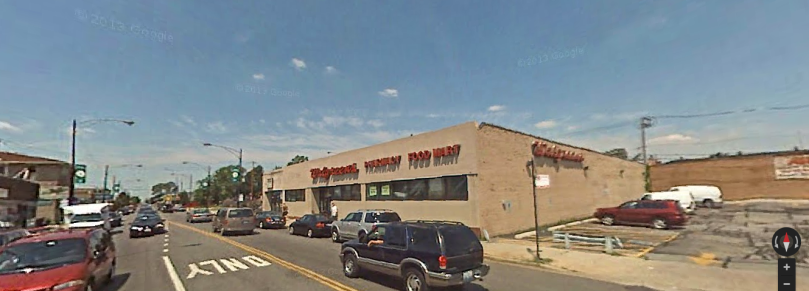
The new Walgreens was a $10.9 million project that included $1.5 million in TIF money plus the city-owned parking lot, which was sold for $1. The TIF money was intended for the purchase of public rights-of-way, “buying private property, demolition and relocating utilities,” according to the Chicago Tribune. For those unfamiliar, here’s what happens in a TIF district. The level of property taxes for public services, from the city to the schools, is frozen for more than two decades. Bonds help cover the up-front cost of major improvement projects in the district, and as property values within the district increase, the incremental tax dollars collected as a result of that growth are captured and put into a special fund help repay the bonds or pay for ongoing projects. The city, school district and other taxing bodies continue to collect the amount established at the creation of the district, while the additional amounts are earmarked for everything from streetscaping to new constriction incentives.
(It’s also worth noting that in order for a TIF district to be established, “blight” conditions must be proven. The definition of “blight” is pretty ambiguous. In a neighborhood with one of the highest median incomes in Chicago and many thriving businesses, I’d argue that a few vacancies hardly constitute “blight. In fact, former 19th Ward Ald. Virginia Rugai’s chief of staff told the Tribune in 2009 — in the thick of the economic downturn — that the area really isn’t in too bad of shape: “This is a conservation TIF. It’s a different type of TIF. The argument is, ‘Why wait until the area is completely depressed, why wait to build it back?'”)
You Get What You Pay For
So what are 111th Street businesses and property owners paying for in the case of Walgreens? Aside from a new building, they are getting the elimination of one storefront that could have housed another small business, a massive parking lot for Walgreens (that deadens the public realm) and access to drive-thrus for both the Walgreens and a neighboring Dunkin’ Donuts. Who won here? Sounds like mostly Walgreens. And a little bit like Dunkin’ Donuts.
Oh, the district also got that sitting area and brick archway. Now, I’m the first person you will hear advocating for good public gathering places. In the right location, public squares, small parks and other nooks can add tremendous value to the area. Just look at the grand public squares of European cities or smaller public spots in places like Lincoln Square and Elmhurst. These spaces and their surrounding buildings strengthen each other. Restaurants open their doors to these squares, creating spaces for patrons to dine. Residents have a place to spontaneously bump into a friend — or stranger — and have a pleasant interaction. These spaces thrive on the foot traffic created by the surrounding uses, and the surrounding businesses benefit from a strong public realm.
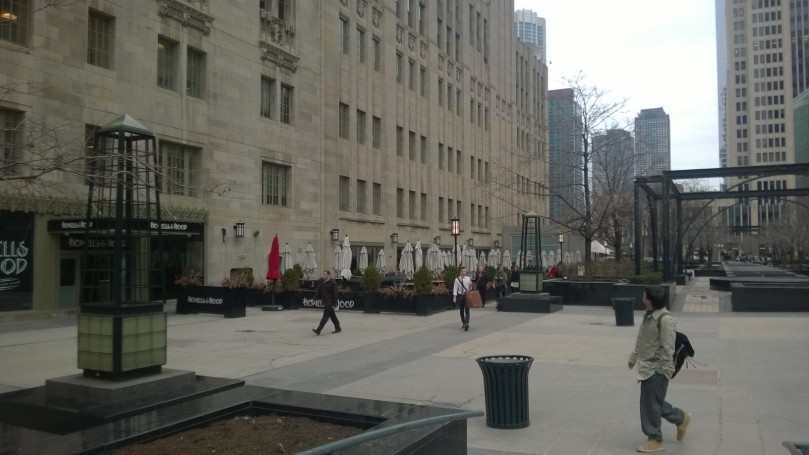
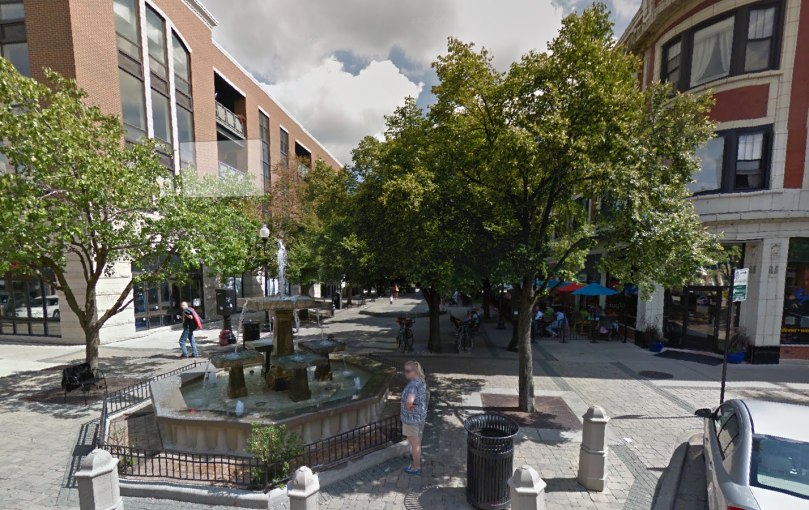
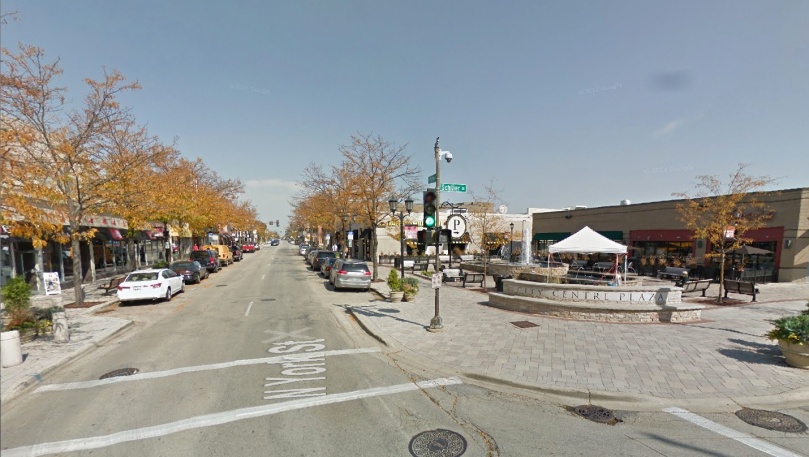
Now, let’s look again at that seating area at 111th and Kedzie.

The backdrop is a parking lot. On either side are driveways that cut across the sidewalk, allowing cars to access said parking lot. Only two nearby corners have what could be considered to be pedestrian friendly design. The other has another parking lot. This public space fails on almost all accounts. We don’t see that synergy of public space and private use that creates such vibrant places in other cities and other neighborhoods.
But back to the neighborhood improvement plan. Encompassing nearly the same area as the TIF district is an SSA, which differs slightly. In order for an SSA to be established, a majority of property owners must agree to it. If created, an additional tax is levied on properties within the boundaries to help fund improvement projects similar to those a TIF district supports. The Mount Greenwood SSA helps fund everything from commercial corridor studies to marketing to sidewalk maintenance.
More Valuable Walkability Funds More Sprawl
According to the Mount Greenwood SSA’s 2012 plan, the annual budget is estimated to be between $63,500 and $71,500 from 2013 through 2017. That five-year budget forecast, about $337,000, is just 22 percent of the entire one-time subsidy given to the sprawling Walgreens development. If the tiny budget allocated to aesthetic improvements increases property values as intended, what happens to that incremental growth? Because the SSA and TIF district overlap, that incremental tax revenue goes to the TIF fund to support more sprawl identified in the Camiros plan, which is in direct contrast to the welcoming pedestrian environment the area’s redevelopment plan purports to champion.
Some of you might be saying, “Jeff, what’s the problem here? We had a vacant building and a prominent parking lot; now we have a new shopping area.” First of all, we still have a parking lot in the same space — and now it’s larger. True, in a survey accompanying the SSA proposal, the third most pressing concern to respondents was parking — 16 percent of people said parking was their least favorite part of the district, and 17 percent of people said they would improve parking. However, they also indicated a desire to improve things that impact the pedestrian experience — more attractive storefronts and a better business mix were the top two improvements in the survey, while street and sidewalk beautification came in just behind parking. Traffic was a mild concern, but respondents indicated that improving parking was one of the least of their priorities.
Parking concerns are certainly understandable in a popular place. Like traffic, it’s a good problem to have. That means people want to come to the area. And people usually want to go to a place because of the vibrancy, the convenience and other attractive qualities that generally occur due to the fact that there isn’t an overemphasis on parking. Places worth caring about — and I would certainly consider Mount Greenwood one of those — don’t tear out their assets for abundant parking. Otherwise, those positive qualities — those public realms — begin to erode. Too much parking simply induces demand for driving. In addition, the Camiros plan also states “additional traffic lanes might be warranted” for the district in the future. With more people driving to an area due to more parking, possibly more travel lanes, and a general decrease in pedestrian focus, it’s only a matter of time before traffic concerns grow and we start looking for another way out of the mess.
Second, as I’ve written in the past (here and here), sprawl is an investment with a low return rate. The more traditional development pattern is exponentially more valuable on a per-acre basis, expanding our tax base to support better services, infrastructure maintenance, schools, parks and anything else that property taxes fund. Our mixed-use corridors, like 111th Street, are the most valuable parts of our city. We should be looking to intensify uses there rather than spreading development thin.
Finally, surveys these days are indicating a growing desire to live in walkable, mixed-use neighborhoods, particularly among millennials. More pedestrian-oriented development could help make the neighborhood more attractive to younger people and others who crave walkability.

Alternatives
Moving forward, I’d suggest a counterproposal for any future development. If the local redevelopment organization and/or the city possess certain properties, then they should place more controls on what is built there. Subdivide the properties and work with multiple developers to build mixed-use on the parcels. If the parties feel that some parking is needed — and to reiterate, I don’t necessarily believe this is the case — collaborate to establish general public parking behind the buildings that can be used for any person visiting any place within in the district. Residences above the storefronts would help provide the foot traffic to support the businesses on the ground. And instead of a small seating area wedged between a parking lot and a street, develop a plaza where businesses could open their doors to the public realm.
The result would be a development that creates value in the community and is infinitely more pedestrian friendly than what we are currently getting. Mount Greenwood’s main business district is full of advantages, from a mix of housing types to narrower streets than we see elsewhere in the area. Those are assets we should be building on. All the streetscaping in the world won’t make an area more attractive if we destroy the public realm with auto-oriented development, and small businesses will have trouble competing if our subsidies favor sprawl.
(P.S.: The Walgreens development does include one very nice feature: A path is paved with bricks that honor police officers and firefighters, many of whom live in the neighborhood. I left this out of the main discussion, because I feel that it is a separate issue from the overall walkability of the development. While I feel that a walkway around a parking lot is hardly an example of pedestrian-friendly design, the commemorative bricks are a nice touch — the type of detail that speaks volumes about the people who live in the community.)

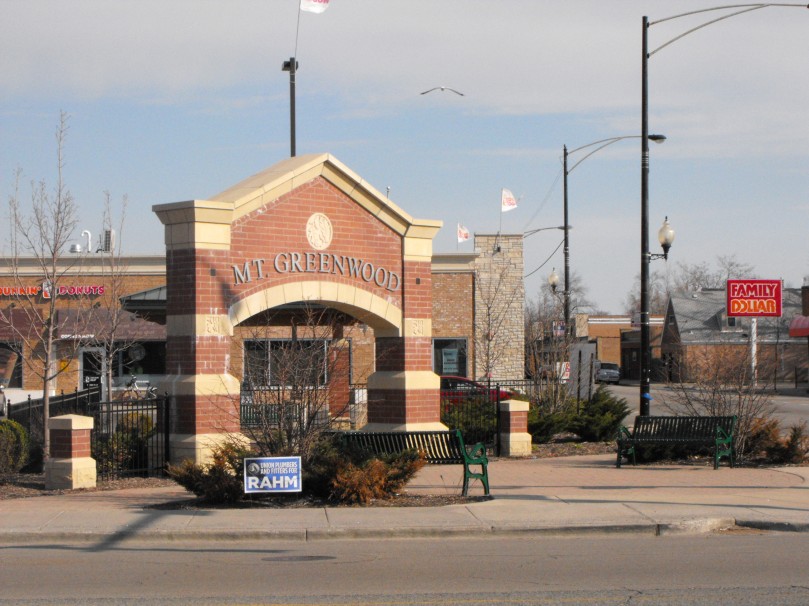
Great article. Where do you suppose a public square like the one in Lincoln Square could go (Mt. Greenwood or even in Beverly)?
Also traffic on 111th near that Walgreen’s/Kedzie as well as parking in that area can be horrendous. I believe there is a plan to “beautify” 111th around Kedzie in the near future too. 111th may also be a great location for bike lanes but again, the local businesses seem to need those parking spaces on the street.
Anyway your article highlights, at lest for me, that a lot is possible around Kedzie and 111th.
LikeLike
Thanks, Mark! I don’t necessarily think that corner is a bad place for a public square, but I would love to see one that has a better interaction with its environment. If it was surrounded by buildings with storefronts that opened out to it rather than a parking lot, I could see it being used more frequently. The Elmhurst example illustrates this well. It’s a spot where I often dined when I worked in the area, and others did, as well. It also was the location of public ceremonies like Christmas tree lightings.
I hear you about traffic, but adding parking on that corner will only make it worse. I’m reading some fascinating things about parking in Jeff Speck’s book “Walkable City” that I hope to write about soon. The key isn’t necessarily blindly adding more parking but rather looking at parking strategically. Shared off-street parking in a location that doesn’t detract from the pedestrian way is essential, as is on-street parking. The other key is to charge for it. It seems counterintuitive, but charging even a small fee for parking allows for more turnover and more frequently open spaces closer to businesses. In places where this was done, such as downtown Pasadena, CA, economic activity actually increased. Essentially, parking is a service/good, and providing it for free does a disservice to the area.
Right now, we’ve added free, off-street parking for one business (maybe two). If we can get the price right and make our parking shared, we would benefit.
LikeLike
P.S.: In some cities that instituted parking fees, the revenue has been put back into streetscaping and other initiatives in the neighborhoods. Unfortunately, with Chicago’s parking meter deal, we’d probably run into some trouble doing something similar, just another example of how we shot ourselves in the foot with the meter lease.
LikeLiked by 1 person
So far, I really like this blog! I grew up in a nearby suburb and my husband and I just bought our first house in Morgan Park (near the BAC).
I think the points about shared off-street parking are really good. There are quite a few suburbs that seem to use this in their downtown areas effectively. (LaGrange and Naperville come to mind). I can remember going to LaGrange as a kid and the downtown area along LaGrange Rd near their Metra station was basically devoid of activity and pretty run down. They’ve added some parking garages and lots behind the businesses (I can’t remember whether they’re free during certain periods, but cost $ during others, or always free, or always cost $) and it seems to be working – there’s lots of vibrant mixed restaurants/small businesses and there always seems to be tons of pedestrian traffic in the evenings and on weekends. There are also a concentration of apt/condos in those areas (I think this is happening in Bev along 103rd and Longwood) that lend themselves to pedestrian traffic and less car traffic. I think the areas along Longwood close to all the Metra stops are ripe for this sort of development as well as along 111th St. I agree that it would work along 95th but there would be a lot of resistance among residents who live in the side streets (we decided against a number of houses within a block or two in either direction of 95th St for just that reason) – there’s more public transport options along E/W 95th than along N/S Longwood but Longwood is definitely much safer for pedestrian traffic.
Sorry for the novel, but thanks – your posts have definitely gotten me thinking about our area in a different and better way.
LikeLike
Walgreens tried to demolish an existing corner near the Kimball stop on the Brown line to put in a similar auto-friendly design. Fortunately we were able to stop it, as it required a zoning change that Ald Mell blocked. Then Walgreens pulled out.
Two things that I think make Giddings Plaza (the Lincoln Square space) work really well is a) it’s surrounded by 3 cafes/restaurants where you can sit and look onto it and b) they have a ton of events there to help make people come out — summer concerts, festivals, etc. It helps.
LikeLike
I remember reading about that Albany Park Walgreens proposal, and it seemed like it would be such a waste if it went through. I’m glad to hear you were successful in blocking it. With such a busy CTA station right there, there is no need for such an auto-centric design.
Gidding Plaza could almost be considered the gold standard for neighborhood plazas in Chicago. You’re right — the level of DAILY activity around there is what makes it succeed. All the public events are just gravy. It doesn’t even matter that it creates a dead end in the street network, because the area is so walkable. Pretty much every neighborhood can learn from that.
LikeLike
[…] in this area will not be patronizing any other shops. This is the argument I made about the massive Walgreens parking lot in Mount Greenwood. Not only are we incentivizing driving to the area at the expense of our public realm, we are […]
LikeLike
[…] quilting supplies. But we also continue to bank on the status quo with drive-thru fast food joints, Walgreens and an auto parts store that is one of the more misguided developments I’ve seen in recent […]
LikeLike
[…] I’ve written before, 111th is one of the most pedestrian-friendly districts in the 19th Ward, whose highly walkable […]
LikeLike